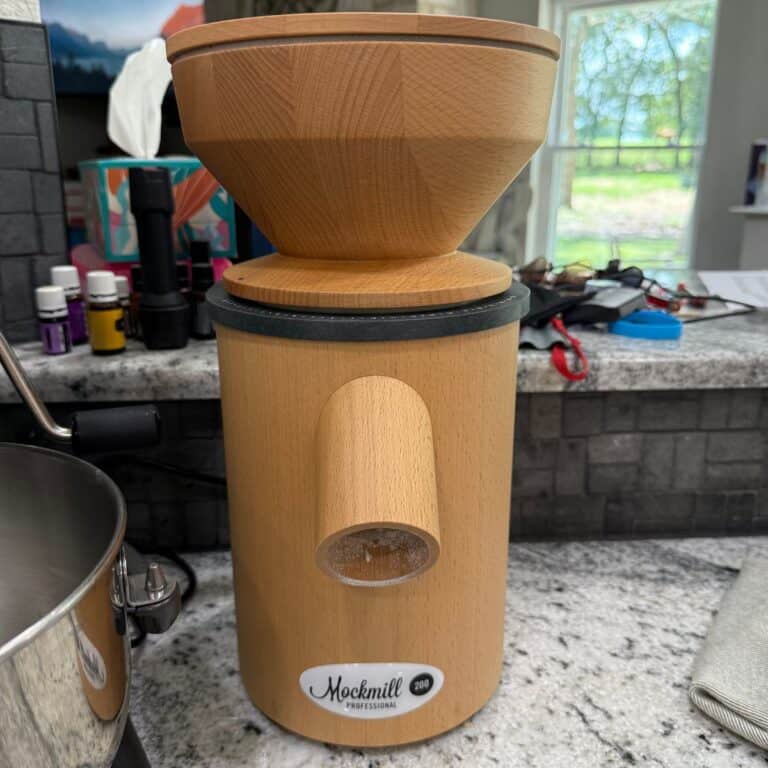Transitioning from All-Purpose Flour to Freshly Milled Flour
You know you want to start using freshly milled grains, but don’t really know where to start? Well this post is for you! We have some great tips and tricks to help you smoothly transition from all-purpose flour to freshly milled flour.

If you haven’t already, you’ll want to read all about hydration and autolyse, where to buy organic wheat berries, and what kind of grain mill should I get? But the purpose of this post is all about transitioning from using that all purpose flour we are so used to using, to freshly milled flour.
Start Slowly
The best advice I can give you, is to start slowly. For example, before I started using freshly milled grains, I was already making homemade sourdough bread, hamburger buns, rolls, pancakes, waffles, bagels, and English muffins. Not to mention all the baked goodies I love to make like cookies, muffins, donuts, cakes and more!
My goal to nourish my family over the years has been to cook from scratch using the freshest ingredients. So when I started using freshly milled grains, I started with my homemade Belgium Waffle Recipe. I substituted half of the all-purpose flour with freshly milled flour.

We got the same great tasting homemade waffle, with a touch of the newness of the freshly ground flour. Today most of our baked goods are made fully with freshly milled flour!
TIP: Start using 50% Freshly Milled flour and 50% All-Purpose Flour when baking your favorite recipes to adjust to taste and consistency gradually.
Don’t Rush to Make a New Sourdough Starter

Another slow transition I made was with my sourdough starter. I read somewhere that people try to rush into making a brand new sourdough started with freshly milled grains, but don’t really understand the hydration difference yet, so it fails to thrive.
Because of that advice I kept my all-purpose flour sourdough starter that I’ve had for years and used that in my recipes for a while before trying to make a brand new sourdough starter with freshly milled flour.
Learn How to Adjust Recipes with Freshly Milled Flour
One of the reasons I’ve created this blog is because there is a lack of resources available about baking with freshly milled grains. Specifically within recipes. I would love to say it’s an easy switch to adjust recipes, but the truth is they change depending on what you are trying to do, which type of grain you are using and what kind of consistency you want.
More Tips for Transitioning to Freshly Milled Flour
- Adjust liquid quantities as freshly milled flour may absorb more moisture.
- Allow doughs to rest longer to hydrate the bran and germ.
- Experiment with recipes that naturally complement whole grain flours (e.g., hearty breads, muffins).
I have learned that when I make my Sourdough English Muffins Made with Freshly Milled Grains, that I have to add more water than the recipes originally called for with all-purpose flour or it gets too tough and will harden. I’m taking rock solid haha. Good thing I have chickens that get to eat my mistakes! Now, I let my flour and water rest (autolyse) at least an hour, before adding in the sourdough to ferment overnight.

Another big thing is that you can’t just substitute 1 cup of freshly milled flour for 1 cup of all purpose flour. You actually need more of the freshly milled flour because of the space that the bran and the germ take up. I typically use 1 cup of wheat berries, which will then turn into about 1 1/4 – 1 1/2 cups of flour, for every cup of all purpose flour that I needed for a recipe. But again this all depends of the type of wheat berry you are using and their hydration levels.
If you are trying out a recipe on my blog, I try to be pretty specific so that anyone can follow them – even if you’ve never baked a day in your life. If I use a word like autolyse that doesn’t really make sense then I typically either link to another article that explains what I mean, or try to explain it right there in the post.
Really as you dive into the world of Freshly Milled Grains, I encourage you to experiment and embrace the unique qualities of freshly milled flour. Believe me once you start you won’t want to go back to all purpose flour!




